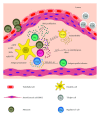T lymphocyte autoreactivity in inflammatory mechanisms regulating atherosclerosis
- PMID: 23304078
- PMCID: PMC3529860
- DOI: 10.1100/2012/157534
T lymphocyte autoreactivity in inflammatory mechanisms regulating atherosclerosis
Abstract
Atherosclerosis has been clearly demonstrated to be a chronic inflammatory disease of the arterial wall. Both cells of the innate and the acquired immune system, particularly monocytes and T lymphocytes, are implicated in the atherogenic process, producing different cytokines with pro- and anti-inflammatory effects. The majority of pathogenic T cells involved in atherosclerosis are of the Th1 profile, that has been correlated positively with coronary artery disease. Many studies conducted to evaluate the molecular factors responsible for the activation of T cells have demonstrated that the main antigenic targets in atherosclerosis are modified endogenous structures. These self-molecules activate autoimmune reactions mainly characterized by the production of Th1 cytokines, thus sustaining the inflammatory mechanisms involved in endothelial dysfunction and plaque development. In this paper we will summarize the different T-cell subsets involved in atherosclerosis and the best characterized autoantigens involved in cardiovascular inflammation.
Figures

Similar articles
-
Adaptive (T and B cells) immunity and control by dendritic cells in atherosclerosis.Circ Res. 2014 May 9;114(10):1640-60. doi: 10.1161/CIRCRESAHA.114.302761. Circ Res. 2014. PMID: 24812352 Review.
-
Subclinical Atherosclerosis in Primary Sjögren's Syndrome: Does Inflammation Matter?Front Immunol. 2019 Apr 17;10:817. doi: 10.3389/fimmu.2019.00817. eCollection 2019. Front Immunol. 2019. PMID: 31110500 Free PMC article. Review.
-
In Vitro Differentiation of Naïve CD4⁺ T Cells: A Tool for Understanding the Development of Atherosclerosis.Methods Mol Biol. 2015;1339:177-89. doi: 10.1007/978-1-4939-2929-0_12. Methods Mol Biol. 2015. PMID: 26445789
-
Adaptive Response of T and B Cells in Atherosclerosis.Circ Res. 2016 Feb 19;118(4):668-78. doi: 10.1161/CIRCRESAHA.115.306427. Circ Res. 2016. PMID: 26892965 Review.
-
Heterogeneity of T Cells in Atherosclerosis Defined by Single-Cell RNA-Sequencing and Cytometry by Time of Flight.Arterioscler Thromb Vasc Biol. 2021 Feb;41(2):549-563. doi: 10.1161/ATVBAHA.120.312137. Epub 2020 Dec 3. Arterioscler Thromb Vasc Biol. 2021. PMID: 33267666 Free PMC article. Review.
Cited by
-
Atherosclerosis and the role of immune cells.World J Clin Cases. 2015 Apr 16;3(4):345-52. doi: 10.12998/wjcc.v3.i4.345. World J Clin Cases. 2015. PMID: 25879006 Free PMC article. Review.
-
Comparing the Protection Imparted by Different Fraction Extracts of Garlic (Allium sativum L.) against Der p-Induced Allergic Airway Inflammation in Mice.Int J Mol Sci. 2019 Oct 1;20(19):4879. doi: 10.3390/ijms20194879. Int J Mol Sci. 2019. PMID: 31581442 Free PMC article.
-
Atherosclerosis: from lipid-lowering and anti-inflammatory therapies to targeting arterial retention of ApoB-containing lipoproteins.Front Immunol. 2025 Jun 9;16:1485801. doi: 10.3389/fimmu.2025.1485801. eCollection 2025. Front Immunol. 2025. PMID: 40552286 Free PMC article. Review.
-
Diclofenac Inhibits 27-hydroxycholesterol-induced Differentiation of Monocytic Cells into Mature Dendritic Cells.Immune Netw. 2017 Jun;17(3):179-185. doi: 10.4110/in.2017.17.3.179. Epub 2017 Jun 20. Immune Netw. 2017. PMID: 28680379 Free PMC article.
-
Dexamethasone Suppresses Oxysterol-Induced Differentiation of Monocytic Cells.Oxid Med Cell Longev. 2016;2016:2915382. doi: 10.1155/2016/2915382. Epub 2016 May 31. Oxid Med Cell Longev. 2016. PMID: 27340507 Free PMC article.
References
-
- Bartoloni E, Shoenfeld Y, Gerli R. Inflammatory and autoimmune mechanisms in the induction of atherosclerotic damage in systemic rheumatic diseases: two faces of the same coin. Arthritis Care and Research. 2011;63(2):178–183. - PubMed
-
- Libby P, Okamoto Y, Rocha VZ, Folco E. Inflammation in atherosclerosis: transition from theory to practice. Circulation Journal. 2010;74(2):213–220. - PubMed
-
- van Leuven SI, Franssen R, Kastelein JJ, Levi M, Stroes ESG, Tak PP. Systemic inflammation as a risk factor for atherothrombosis. Rheumatology. 2008;47(1):3–7. - PubMed
-
- Girn HRS, Orsi NM, Homer-Vanniasinkam S. An overview of cytokine interactions in atherosclerosis and implications for peripheral arterial disease. Vascular Medicine. 2007;12(4):299–309. - PubMed
-
- Nilsson J, Wigren M, Shah PK. Regulatory T cells and the control of modified lipoprotein autoimmunity-driven atherosclerosis. Trends in Cardiovascular Medicine. 2009;19(8):272–276. - PubMed
Publication types
MeSH terms
Substances
LinkOut - more resources
Full Text Sources
Medical

